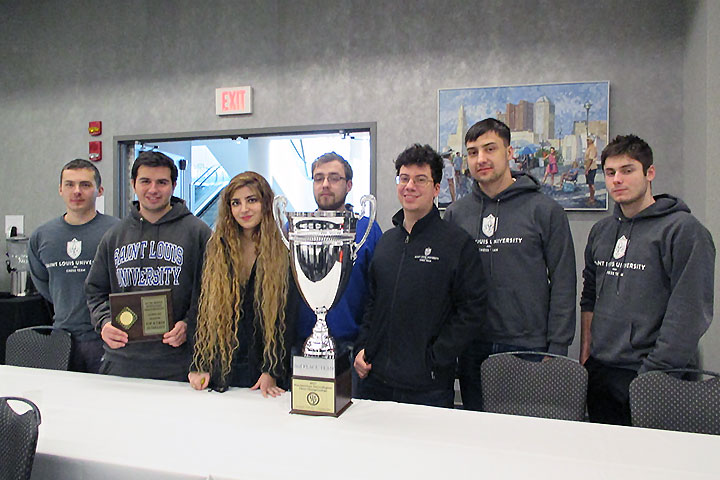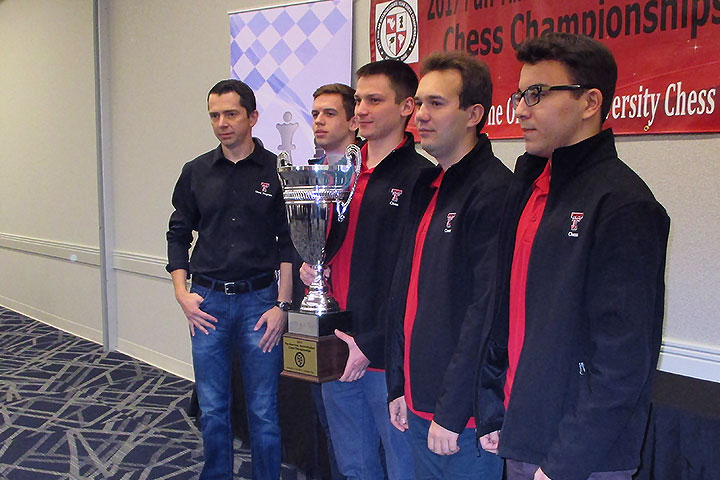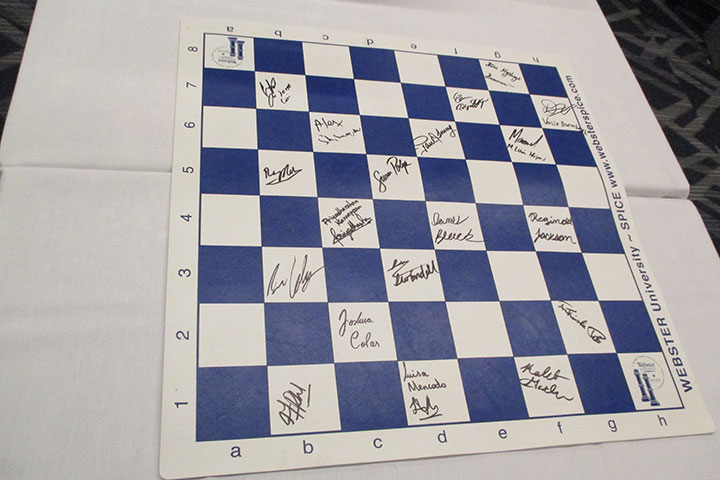To the President's Cup...
Webster University has won the Pan-American Intercollegiate Team Chess Championships (Pan-Am). In round 5, the Webster "A" team tied its match with the UTD "B" team. Since Webster "A" had been the only team going into the round with a perfect 5 out of 5 match wins (UTD "B" had 4½ of 5 going into the last round), a tied match was sufficient for Webster to win the tournament. All the games in the UTD "B" vs. Webster "A" match were draws.
However, the tournament winner title was not all that was at stake in the last round. The top four U.S. schools (colleges or universities) qualify for the President’s Cup, also known as the “Final Four of College Chess,” to be held March 30-April 1, 2018 in New York City. Since Webster “A” won the Pan-Am, Webster University became one of the “Final Four” schools. However, as the last round began, many other teams could finish tied with each other with five out of six match wins. When it tied its last round match with Webster “A,” UTD “B” went from 4.5 to 5 match wins. On the second table, SLU was playing Harvard Crimson, which was led by GM Darwin Yang. Both teams had four match wins going into the round. Playing Black, Yang drew against SLU’s first board, GM Ipatov. However, SLU clinched the match by a 3 to 1 score by drawing on Board 2 and winning on Boards 3 and 4.

Second place: Saint Louis University with Coach GM Alejandro Ramirez | Photo: A. Root
Six additional teams went into round 6 with four match wins per team. Each of those teams tried for one more match win, to catch up with the five match wins earned by UTD "B" and SLU. The six teams aiming for five match wins played each other. In the match UTD "A" versus UTRGV "A," UTD "A" scored ½ and UTRGV scored 3½. In the match of Webster "B" versus UTD "C," Webster "B" scored 2½ and UTD "C" scored 1½. In the match of University of Illinois "A" versus Texas Tech "A," Texas Tech "A" won all four games.

Third place: Texas Tech “A” team with Coach GM Alexander Onischuk | Photo: A. Root
UTD "B" fared the worst in the tiebreaks of teams finishing with five match wins, finishing sixth in the tournament. Webster “B” was fifth on tiebreaks in the Pan-Am. The other teams tied with five match wins had better tiebreaks. UTRGV "A" was fourth on tiebreaks, Texas Tech "A" was third on tiebreaks, and Saint Louis University was second on tiebreaks. Webster University "A" was clear first with 5½ match wins.
Not all the attention was on the top boards in the last two days of the tournament. On December 29th, in round 5, Chief Floor Tournament Director Kathy Lin forfeited the fourth board of the Texas Tech "D" team. She said she heard his cell phone chirp. Lin told the fourth board that he forfeited the game for violating the cell phone possession rule. Perhaps he had not heard the warning about no cell phones, announced by organizer Kelly Bloomfield before every round. Maybe he had not read about the forfeit for cell phone possession in round 4. In any case, his Texas Tech "D" team still ended up tying its match against Ohio State University’s "Grey" team.

Chief Floor TD Kathy Lin with cell phones | Photo: A. Root
The New York Times published an editorial by the second alternate for SLU, IM Dorsa Derakhshani. As she wrote in that article, "I write this from Columbus, Ohio, where my college team is competing in a tournament." She played one game for SLU, in round 1. [In the Times piece Derakshani, an Iranian émigré, condemns dress codes in Saudi Arabia and Iran and writes that she's applying for U.S. Citizenship. -Ed.]

Dorsa Derakhshani in round 1, playing on fourth board for SLU
However, college and university players can already start planning to play many more chess games against each other at next year’s Pan-Am, which will be December 27th to 30th, 2018 at the Hyatt Regency San Francisco Airport. Information about next year’s tournament will be available from the organizer, BayAreaChess.
For standings of all 58 teams who played in this year’s Pan-Am go to buckeyechess.com.
All available games of Round 6
The Caro-Kann Defence, which arises after the moves 1.e4 c6 followed by d7-d5, is considered to be one of the most reliable defences to White’s 1.e4. Black fights for his share of the centre and patiently awaits his chance. Shirov’s preferred weapon against this solid setup by Black has always been the Advance Variation 3.e5 - with chances and risks for both sides.
Correction, December 31st: An earlier version of this story incorrectly identified Webster as having won "six years in a row". In fact, in 2015 Webster "B" finished third on tiebreak, and the tournament was won by Texas Tech University's "A" team — although both scored the same number of match points (5 out 6). Webster's "A" team scored just 4½ points in 2015 and placed fifth.
Update, January 4th: The correction above was made after reviewing the official tournament rules which state the following (emphasis added):
If two teams are tied for first, they are considered co- champions. Tie-breaks are used to determine which team name "goes first" in articles, and which team gets the larger trophy. The recipient of the second place trophy can have it send it [sic] for a new engraving declaring that team "co- champion." If three or more teams tie, tie-breaks are used to determine first, second, third, etc. places.
Since then, ChessBase and the story's author Alexey Root have been seeking to clarify the tiebreak rules governing tied Pan-Am teams, to determine whether it is in fact fair to say that Webster University has "won six years in a row", as the original headline did. We now have an answer: Yes, it is, and we have returned the story's original headline accordingly.
According to Al Lawrence, Chair of the College Chess Committee, it's customary to refer to teams that tie for first place with the same match points as "co-champions". He consulted with Boyd Reed, Director of Events at United States Chess Federation, who replied as follows:
The specific rules covering the Pan-American Intercollegiate are maintained by the College Chess Committee of the US Chess Federation. As far as I can tell, the latest version of those rules is here [the same document linked above from the USCF]. Rule 2h, on page 12 of the linked document, specifically states that, in the case of a two-way tie for first, both teams are considered co-champions. However, while the rule discusses tie-breaks in the case of a larger tie for first, it is silent on the question of whether all such teams are co-champions.
So, I’m not entirely certain that the college chess rules address the question of which team(s) are eligible to claim the title of 2015 Pan-American Intercollegiate Team Champions. I would think that resolution of this question belongs with the same body that controls the rules for this issue – namely, the College Chess Committee. I might also suggest to the committee that they should clarify the relevant portion of Rule 2h.
Lawrence replied, "The Committee will pay attention to its rule this year to clarify. I favor the custom of permitting all those in the top score group to claim being co-champions. But it will be up to the Committee and then the EB to approve."
Boyd also notes that USCF national regulations in scholastic chess allow "teams in the top score group of a championship section of a national event are to be designated as national co-champions. However, those regulations only cover grade levels K-12."
Also worth noting, those national events use individual pairings not a team Swiss system, like the Pan-Ams. As a historical parallel, other major team championships — such as the Chess Olympiad and the European Team Championship — use tiebreak criteria such as a team form of Sonneborn-Berger, board points scored, to determine the winner between teams tied on match points.
All this is not to diminish the remarkable achievements by Webster, its players and coaches, in any way! But the rules should indeed be clarified.
Links
































